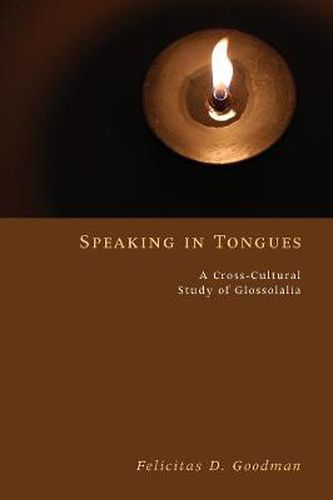Readings Newsletter
Become a Readings Member to make your shopping experience even easier.
Sign in or sign up for free!
You’re not far away from qualifying for FREE standard shipping within Australia
You’ve qualified for FREE standard shipping within Australia
The cart is loading…






This title is printed to order. This book may have been self-published. If so, we cannot guarantee the quality of the content. In the main most books will have gone through the editing process however some may not. We therefore suggest that you be aware of this before ordering this book. If in doubt check either the author or publisher’s details as we are unable to accept any returns unless they are faulty. Please contact us if you have any questions.
Speaking in tongues, or glossolalia, is practiced in many different religions around the world. Dismissed as meaningless gibberish by some observers, it has been the subject of only a few fragmentary studies. The work of Felicitas D. Goodman represents the first cross-cultural analysis of this enigmatic behavior, and she brings to her research an extensive background in linguistics and anthropology. Dr. Goodman’s fieldwork included living with apostolic congregations in Mexico City, in the Yucatan with Maya Indians, and visits with a congregation in Hammond, Indiana. Her observations were preserved on a remarkable collection of sound recordings and films. For this book she presents a selection of conversion stories that highlights the personality structure and experiences of the speakers. A detailed analysis of the phonological and suprasegmental features of the recorded utterances show a surprising cross-cultural agreement. This led Goodman to believe that glossolalists speak the way they do because their speech behavior is modified in a particular mental state, often termed trance, into which they place themselves. In this light the glossolalia utterance is seen as an artifact of a hyperaroused mental state, or, in Chomskyan terms, as the surface structure of a nonlinguistic deep structure, that of the altered state of consciousness. Goodman describes the hyperaroused mental state as a neurophysiological phenomenon, as well as the associated patterns of movement, and the problems of waking from it. Goodman’s diachronic approach yielded equally surprising data about the changes and the waning of the behavior over time. But, as she observes, we have barely touched the edge of a very large area of inquiry. Her fascinating study opens a number of new avenues of research for anthropologists, such as the study of physiological states accompanying linguistic and ritual behavior.
$9.00 standard shipping within Australia
FREE standard shipping within Australia for orders over $100.00
Express & International shipping calculated at checkout
This title is printed to order. This book may have been self-published. If so, we cannot guarantee the quality of the content. In the main most books will have gone through the editing process however some may not. We therefore suggest that you be aware of this before ordering this book. If in doubt check either the author or publisher’s details as we are unable to accept any returns unless they are faulty. Please contact us if you have any questions.
Speaking in tongues, or glossolalia, is practiced in many different religions around the world. Dismissed as meaningless gibberish by some observers, it has been the subject of only a few fragmentary studies. The work of Felicitas D. Goodman represents the first cross-cultural analysis of this enigmatic behavior, and she brings to her research an extensive background in linguistics and anthropology. Dr. Goodman’s fieldwork included living with apostolic congregations in Mexico City, in the Yucatan with Maya Indians, and visits with a congregation in Hammond, Indiana. Her observations were preserved on a remarkable collection of sound recordings and films. For this book she presents a selection of conversion stories that highlights the personality structure and experiences of the speakers. A detailed analysis of the phonological and suprasegmental features of the recorded utterances show a surprising cross-cultural agreement. This led Goodman to believe that glossolalists speak the way they do because their speech behavior is modified in a particular mental state, often termed trance, into which they place themselves. In this light the glossolalia utterance is seen as an artifact of a hyperaroused mental state, or, in Chomskyan terms, as the surface structure of a nonlinguistic deep structure, that of the altered state of consciousness. Goodman describes the hyperaroused mental state as a neurophysiological phenomenon, as well as the associated patterns of movement, and the problems of waking from it. Goodman’s diachronic approach yielded equally surprising data about the changes and the waning of the behavior over time. But, as she observes, we have barely touched the edge of a very large area of inquiry. Her fascinating study opens a number of new avenues of research for anthropologists, such as the study of physiological states accompanying linguistic and ritual behavior.